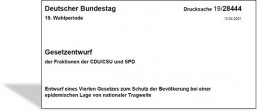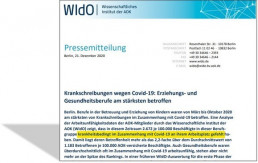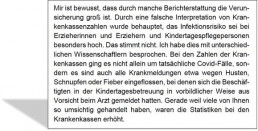Scottish study shows: teachers have a 64% lower risk of developing severe disease with COVID 19
Kita closures:
German government justifies restriction of children´s rights based on fake news
„Oops, they did it again.” Despite political promises to the contrary, last month kindergartens in large parts of the country had to close their doors again to the general public. Only emergency groups had been allowed and hundreds of thousands of children have been sent home again. As our research shows: the federal government´s justification for this massive encroachment of children´s rights – is based on fake news published by public health fund AOK.
Accompanied by strong protests, the Bundestag in Berlin had passed a revision of the Infection Protection Act last month. With the votes of the governing coalition, a new §28b was inserted.
This paragraph regulates that from an “incidence value” of 100 a general Corona test obligation for children applies in schools and that from a value of 165 distance learning in schools is required as well as the transition of kindergartens to an emergency setting only. (Source: www.gesetze-im-internet.de/ifsg/__28b.html):

Note: “Facilities according to § 33 number 1 and 2” relate, among other things, to kindergartens.
The detailed draft law of the federal government can be viewed on the website of the German Bundestag (source: dip21.bundestag.de/dip21/btd/19/284/1928444.pdf):

In its proposed legislation, the federal government justifies daycare and school closures by citing concerns that teachers (and, by analogy, kindergarten educators) could potentially easily infect a larger group of children because of the large number of people they interact with during the day. This is, in principle, the concern of superspreading events in community care settings.
In the proposed legislation, even this very broadly worded fear is enough to, in consequence, deprive hundreds of thousands of children in large parts of the country of their right to education and community. However, the federal government does not provide figures on the number and extent of any superspreading events in daycare centers. Neither for our centers nor for other kindergartens in Cologne are we aware of any such incidents in which adults or children had fallen ill with COVID-19 on a massive scale, had to be treated, had died or had suffered long-term consequences.
Even 15 months after the start of the pandemic, the proposed legislation of the German government justifies a far-reaching restriction of the fundamental rights of hundreds of thousands of children not based on facts but on general assertions. This fear scenario is then further linked with the assertion that the Sars-Cov-2 virus would be detected particularly frequently among teachers. Data evaluations of the health insurance companies are brought by the government as evidence for their claim (Quelle: dip21.bundestag.de/dip21/btd/19/284/1928444.pdf):

As our investigation will further show, the data evaluations cited by the government are not conclusive.
Shortly before Christmas 2020, Dr. Kai Behrens from the press office of the AOK’s scientific service wrote (source aok-bv.de/presse/pressemitteilungen/2020/index_24186.html):

In the study, the impression was conveyed on the basis of AOK insurance data that employees in kindergartens were particularly likely to contract COVID-19. In public reporting, the AOK data were interpreted to imply that kindergartens had become hotspots of the pandemic. For example, the Bremen based Weser-Kurier headlined: „Educators have the highest Corona risk“ and the Schweriner Volkszeitung wrote „Endangerment in kindergartens is clearly greater than in health care professions“.
This assessment had already taken us completely by surprise at the time of publication, because it did not match at all with the figures that we rainbowtrekkers as daycare providers and employers had collected throughout the past calendar year. We had therefore consulted other Cologne daycare providers and the North Rhine-Westphalia regional association of the German Daycare Association. No one could quite explain the figures.
However, it was clear from the press release that the data provided by the AOK was not a study that met scientific standards. We had doubts about both the compilation and the interpretation of the data, i.e. the entire design of the evaluation. Above all, the formulation “missed work due to illness in connection with COVID-19” seemed quite unusual to us. At this point, our working hypothesis was that the high total number was due, among other things, to many sick leaves by members of at-risk groups who had not been deployed at all in daycare centers nationwide by their employers during the initial lockdown, as well as to sick leaves by educators as a result of caregiver absences for their own children. Because we wanted to clarify this, we had sent an e-mail inquiry to the Scientific Service of the AOK on January 31, 2021. In this, we asked the AOK for information about:
- which data have you used as the basis for your investigation and
- how did you collect this data and which cases are specifically meant by “absence due to illness in connection with Covid-19 at work”?
- Did these people test positive?
- Were they infected and showing symptoms?
- Have they been in quarantine after contacting a confirmed case?
- Were they on sick leave because one of the above-mentioned cases applied to their children?
- Were they on sick leave because they had to look after their own children at home due to daycare and school closings?
- Were they on sick leave because they belong to a risk group and their employer asked them to take sick leave because reimbursement through the Infection Protection Act was not available to him?
- If several criteria apply: What was the numerical relationship between the individual criteria?
The following day, we received a general answer from the deputy managing director of the scientific institute of the AOK, Helmut Schröder, who referred us to a corresponding chapter in the AOK “Absenteeism Report 2019” with regard to the questions about the methodology, which was insofar humorless as in this absenteeism report for the year 2019, of course, the COVID-19 topic had not yet arisen at all. We therefore took the liberty of asking the AOK again more precisely on the same day:
- From the reference to the absence report 2019, I understand that the data for the corona statistics are based on the ICD-10 GM codes. Is this analogy correct? If so, can you please tell me which of the codes were used?
The ICD codes are a classification system for medical diagnoses. Medical sick notes in Germany must be coded with these ICD codes in accordance with the German Social Code Book V. Using these codes, health insurers can draw anonymous statistical conclusions, e.g., about the prevalence and duration of illnesses in the country. In his second reply to us, the Deputy Managing Director still did not address our questions about the methodology, but at least named the two ICD codes on which the evaluation was based, namely (translated quote from his e-mail):
- U07.1!COVID-19, virus detected: Code provided for COVID-19 cases in which SARS-CoV-2 virus has been detected by laboratory test.
- U07.2!COVID-19, virus not detected: The code is intended for COVID-19 cases in which SARS-CoV-2 has not been detected by laboratory test but the disease is present based on the clinical criterion (e.g., symptom compatible with COVID-19) and an epidemiologic criterion (e.g., contact with a laboratory-confirmed COVID-19 case).
However, the exact relations between “U07.1” (virus detected) and “U07.2” (virus not detected) were only revealed to us after two further persistent inquiries in mid-February 2020. According to this, the virus had actually been detected in only 53.9% of the cases and the corresponding sick note had hence been coded with “U7.1”! In our opinion, the AOK’s concealment of this fact is in itself a deliberate misleading of the public, which makes one wonder what its aim is and whom it serves. The real scandal, however, becomes apparent when one draws the reverse conclusion from the smoke candles thrown by the health fund: If only 53.9% of all sickness notifications are coded as “U07.1”, then this means that almost every second sickness notification on which this evaluation by the AOK was based was instead coded as “U07.2”, i.e. that no virus was detected at all, even if a PCR test had been carried out! Should this explain why our health statisticians had hardly found any cases of common flu in the past year? Have normal cases of common cold in kindergartens been “relabeled” as covid cases by the health fund?
This is precisely the conclusion reached by Prof. Dr. Christof Kuhbandner, holder of the Chair of Educational Psychology at the University of Regensburg and an expert in the field of scientific methods and diagnostics. In an expert opinion for the Weimar Local Court (openjur.de/u/2334639.html) he writes on the question:
- Since individuals with a mere suspected diagnosis do not have a positive SARS-CoV-2 test result, it is very likely that in such cases it is actually just a harmless cold.
- It is a common practice in daycare centers for educators to always get tested immediately for mild cold symptoms and then have to take sick leave until the test result is received. The suspected diagnosis U07.2! is then noted on the sick note. If the test result then shows that there is actually no SARS-CoV-2 infection, the initial suspected diagnosis U07.1! is actually a false COVID-19 diagnosis. The problem with the AOK’s analysis is that it does not distinguish whether a “COVID-19 diagnosis” on a sick note may be a mere tentative diagnosis. Thus, it could be that people working with children simply get tested especially often on suspicion (diagnosis U07.2!), but in reality do not get sick more often with COVID-19 (U07.1!).
Not only the Weimar District Court considers Prof. Kuhbandner’s expert opinion to be credible. The North Rhine-Westphalian Ministry of Family Affairs also assesses the correlations in the same way. Minister Stamp writes on 16.02.2021 (www.kita.nrw.de/datei/ministerschreiben-kindertagespflege-betrieb-ab-2202-und-perspektiven):
- “I am aware that some reports have caused a great deal of uncertainty. Through a misinterpretation of health insurance figures, it was claimed that the risk of infection is particularly high among educators and daycare workers. This is not true. I have discussed this with various scientists. The health insurers’ figures did not only include actual covid cases, but also all sickness notifications, for instance, due to coughs, colds or fevers, where employees in daycare had reported to the doctor in an exemplary manner out of precaution. It was precisely because many of you acted so thoughtfully that the statistics at the health insurance companies were elevated.”

Although the previous representations of the AOK are thus proven scientifically untenable, the health insurance company continued to adhere to its criticized course. Only three weeks after the criticism of Minister Stamp, on 09.03.2021 the AOK published a further evaluation according to the same, misleading principles (www.wido.de/news-events/aktuelles/2021/krankschreibungen-aufgrund-von-covid-19)! While the previous evaluation shortly before Christmas (at that time the Kita closings during the December lockdown had to be politically justified) had referred only to the months March to October 2020, now in March 2021 the AOK supplied the numbers up to December 2020. The procedure was the same and the relation between the two ICD codes also remained very similar.
Different from before, this time the AOK pointed out the differences between the two ICD codes “U07.1” and “U07.2”. At the same time, however, a new smokescreen was thrown, as the they postulated the presence of both a clinical symptom and an epidemiological criterion (e.g. contact with a person with a confirmed infection) for the coding “U07.2”.

This appears to be a deliberate misstatement. A look at the ICD register of the WHO (icd.who.int/browse10/2019/en#/U07.2), which is used by general practitioners and specialists all over Germany for data collection, clearly shows that the code U07.2 is not an AND, as falsely presented by the AOK, but quite clearly an OR specification.
According to this code, general influenza cases could have very well been summed up without any epidemiological criterion, exactly as criticized by Prof. Kuhbandner and Minister Stamp.
One month after the publication of this newly rehashed AOK fake news, the federal government then submits its proposed legislation on April 13, 2021, justifying school and kindergarten closures with the very data provided by the AOK. It’s kind of hard to believe in co-incidence in this case.
The raw data from sick leaves, suggestively provided by the AOK, does not represent a valid data basis which would even be able to remotely reflect the prevalence of Covid-19 in the daycare sector. Researchers from Scotland have shown how to approach this topic differently while meeting scientific standards. In a large-scale study, they had investigated all Corona cases occurring in the country not only quantitatively but also qualitatively (www.medrxiv.org/content/10.1101/2021.03.02.21252734v1.full.pdf):

In doing so, they investigated which factors influence whether someone develops severe Covid-19 disease. In contrast to the AOK’s raw data analysis, the Scottish researchers also conducted an epidemiological case-control study in which the results of the study group were compared with the results of a control group.
The validated results thereby very quickly reduce the AOK suggestions to absurdity and clearly show that educators have a 64% reduced risk of severe Covid-19 compared to other professions!
They also demonstrate that the risk of severe Covid-19 disease in adults was reduced by 28% when children lived in the same household.
This effect of children was seen even when adults belonged to a high-risk group (e.g. cancer, severe asthma and other severe chronic respiratory diseases, hypertension, immunosuppression, etc.):

This could be related to the fact that contact with children increases pre-existing immune protection due to cross-reactions with other corona viruses. Another possible explanation could be that very extensive studies have now shown that the viral load in children is in fact lower (www.medrxiv.org/content/10.1101/2021.01.15.21249691v2) – in contrast to what was initially assumed in a statistically incorrectly evaluated study by a group of researchers led by Christian Drosten.
Furthermore, extensive meta-analyzes (jamanetwork.com/journals/jamapediatrics/fullarticle/2771181 and jamanetwork.com/journals/jamanetworkopen/fullarticle/2774102) also indicate that children under the age of twelve in particular become infected less and pass the virus less often than adults.
Kindergartens have a no time been a pandemic hotspot. Press releases like those of the AOK unjustifiably discredit the entire daycare sector and sow fear and panic where a cool head would be appropriate. Politicians should finally protect the risk groups more effectively and let children be children in peace. The federal government could have referred to the scientifically validated data from Scotland. However, they have made a different decision and have written an automatic locking mechanism into the law for all kindergartens in the country, which will take effect again by next winter at the latest.
Members of:



